What is an Operating System?

An operating system (OS) is a software program that manages computer hardware and software resources and provides common services for computer programs. It acts as an intermediary between the user and the computer hardware, allowing users to interact with the computer and run applications.
Functions of an Operating System
An operating system performs several essential functions to ensure the smooth operation of a computer system. These functions include:
- Process Management: The OS manages the execution of multiple processes or programs simultaneously, allocating system resources and ensuring they run efficiently.
- Memory Management: It controls and organizes the allocation and deallocation of memory resources, allowing programs to access the required memory space.
- File System Management: The OS provides a hierarchical structure for organizing and storing files on storage devices, allowing users to create, modify, and delete files.
- Device Management: It handles the communication and interaction between the computer system and various input/output devices such as keyboards, mice, printers, and storage devices.
- User Interface: The OS provides a user-friendly interface that allows users to interact with the computer system through graphical interfaces, command-line interfaces, or a combination of both.
- Security: It ensures the protection of data and resources by implementing user authentication, access control, and encryption mechanisms.
Types of Operating Systems
There are various types of operating systems, each designed for specific purposes and platforms. Some common types include:
- Windows: Developed by Microsoft, Windows is one of the most widely used operating systems for personal computers and laptops.
- macOS: Developed by Apple, macOS is the operating system used on Apple Macintosh computers.
- Linux: Linux is an open-source operating system that is highly customizable and used by individuals, businesses, and organizations.
- Android: Android is an operating system primarily designed for mobile devices such as smartphones and tablets.
- iOS: Developed by Apple, iOS is the operating system used on iPhones, iPads, and iPod Touch devices.
Evolution of Operating Systems
Operating systems have evolved significantly over the years, adapting to the changing needs and advancements in technology. The evolution can be broadly categorized into the following generations:
- First Generation: The first-generation operating systems were simple and primarily focused on executing a single program at a time. They lacked features such as multitasking and graphical interfaces.
- Second Generation: The second-generation operating systems introduced the concept of batch processing, allowing multiple programs to be executed in sequence without user intervention.
- Third Generation: The third-generation operating systems introduced time-sharing, enabling multiple users to access the computer simultaneously through terminals. They also introduced the concept of virtual memory.
- Fourth Generation: The fourth-generation operating systems focused on improving the user interface and introduced graphical user interfaces (GUIs) for easier interaction.
- Fifth Generation: The fifth-generation operating systems are characterized by their ability to support distributed computing and networked systems.
Conclusion
An operating system is a crucial component of any computer system, providing the necessary functionality to manage hardware resources, run applications, and facilitate user interaction. It plays a vital role in ensuring the efficient and secure operation of a computer system.



